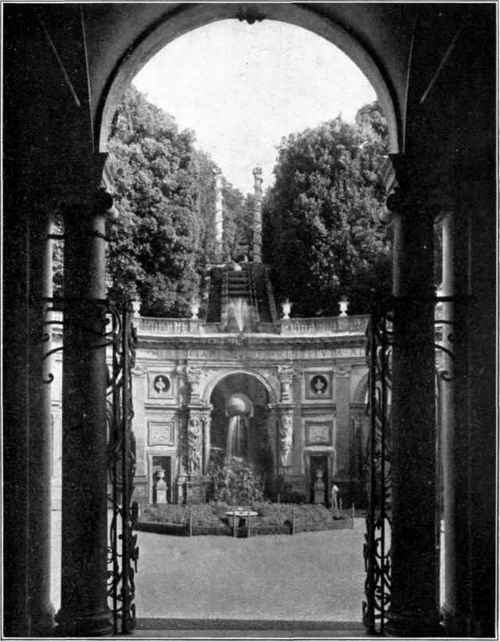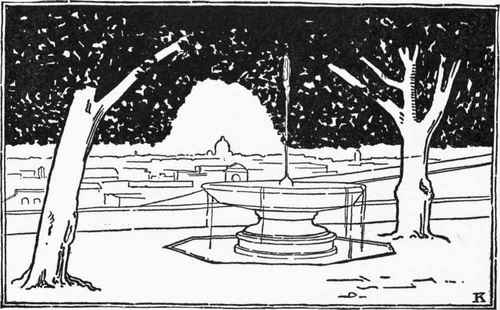Planting. Part 3
Description
This section is from the book "Design In Landscape Gardening", by Ralph Rodney Root, Charles Fabens Kelley. Also available from Amazon: Design in Landscape Gardening.
Planting. Part 3
Plants are grouped as annuals, those that die every year; biennials, those that generally flower the second year and then die out; and perennials, lasting many years; greenhouse plants, which must be grown under glass; bedding plants, which are started in the greenhouse; trees and shrubs which are classified as hardy woody plants.
Planting material should always be chosen with the idea in mind of fitness for the function which it is to perform, and the location in which it is to appear. This has much to do with soil and climate, which determine the scope of available material. The satisfactory relation of plant design to its location may be loosely termed "style in planting." The material should be selected carefully, so that it will seem to harmonize with its setting, whether this is architectural or naturalistic.
For instance, in a colonial garden such as occurs at Mount Vernon, or in the modern estates built on colonial lines, one would expect to find box hedges, the rose of Sharon, or hibiscus, rose arches, perennial phlox, peonies, and hollyhocks (Fig. 25). For decades, all these plants have been so closely associated with colonial gardens that their very presence suggests the proximity of colonial architecture, and they serve admirably to carry out the spirit of the scheme.
In a French garden one always finds bedding plants of gaudy colors, standard roses, bays, and clipped trees.
A Florentine garden does not seem complete without the ever-present cypress tree, box hedges, laurels, crape myrtle, magnolia, and flowering plants in pots. In each of these cases the plant material employed is distinctly different, and yet distinctly characteristic of the class of problem in which it appears.
Balance and unity in planting are virtually inseparable. The scheme must appear to hang together, and not be a number of loosely related parts. This compactness and relation of the divisions of the planting scheme may be called unity, and is achieved through balance. Balance may be secured through color and by shape. It is not necessary that the colors and shapes found on one side of a planting scheme should appear exactly reversed upon the other or opposite side, but only that the colors and shapes of certain interest in a scheme should be balanced by other colors and shapes of equal interest; in fact, symmetrical balance is very seldom found in informal planting. This may mean the employment of different plant material to produce a required effect.
Unity is achieved by keeping all the plants in scale-that is, more or less of the same size-and allowing one color and one quality to predominate. Accent is really an unexpected arrangement, something growing where it might not have been expected, or in such a way as to increase the interest, giving an added sense of pleasure. Great care must be exercised not to introduce it so frequently as to destroy the large and simple relations of the planting scheme. Where every member of the scheme is clamoring for attention, the result is a pandemonium in which no accent will appear. Accent is sometimes achieved by unusual grouping of shrubs, by single shrubs placed in advantageous positions, and by the introduction of exotic varieties. It may also occur in the use of varying shape, color, and size, though the variation should be no greater than is necessary to produce the desired accent. If too great contrasts appear, the accent planting will not seem in keeping with its surroundings, and there will be loss of unity.
Accent is sometimes used to hold the eye within the narrow limits of a small planting scheme, and sometimes to carry it without the boundaries and fix attention upon distant prospects. An example of the first class, where unusual groupings, positions, and unique materials are used, is the Japanese garden (Fig. 11). Probably no two elements in the garden are of exactly the same shape or size; they may not even be of the same color. Each is to a certain extent an accent in itself and possesses a great deal of interest; but all these dissimilar interests are very carefully and subtly balanced, and all occur within such small confines that the eye is held by the interest of the individual plant shapes, colors, and grouping, and by the charm of the accessories, such as stone lanterns, bridges, and tea-houses, so that, indeed, there can be no thought of looking outside the garden.
Italian gardens, on the other hand, from their very position on rocky hillsides, demanded that the distant views form a large part of their charm, and in consequence accent plants and architectural accessories (Figs. 26, 54) as well are constantly placed in such a manner as to direct the gaze of the visitor to the off-scape in various directions. Wherever a particularly beautiful view occurs it is almost certain to be set off or enframed by some planting features (Fig. 27).

Photograph by Anderson.
Figure 26. VILLA ALDOBRANDINI, FRASCATI, ITALY An architectural enframement to emphasize an exterior axis.

Figure 27. ENFRAMEMENT OF VISTA FROM VILLA MEDICI, ROME.
Under the two large heads of the formal and the informal styles will be found different types which must be considered.
Informal planting consists of irregular forms irregularly placed. Free-growing shrubs are used at unequal distances, and the spacing is determined by the spread of the shrub and its age.
Often, when planting for immediate effect, shrubs are set close together, with the intention of thinning them when they have attained a larger growth; but in some cases they are spaced widely so as to allow for subsequent growth without alteration of position. The shrubs are planted so as to express the outline of the bed in which they are placed when they shall have attained their growth.
Continue to:


